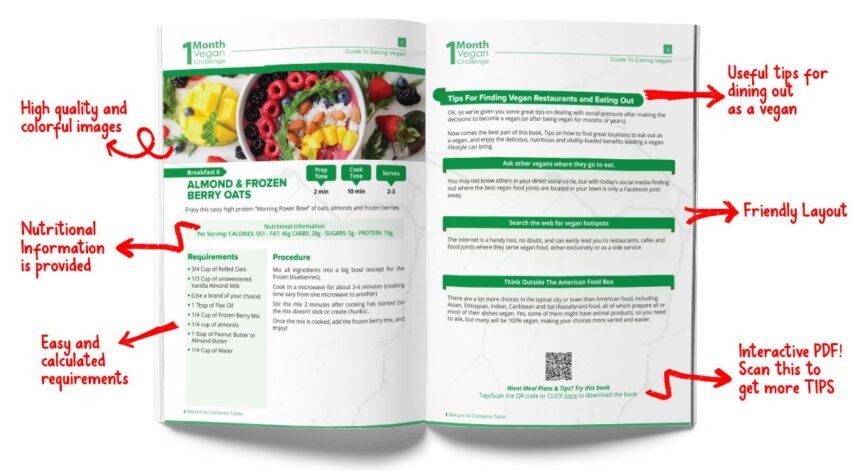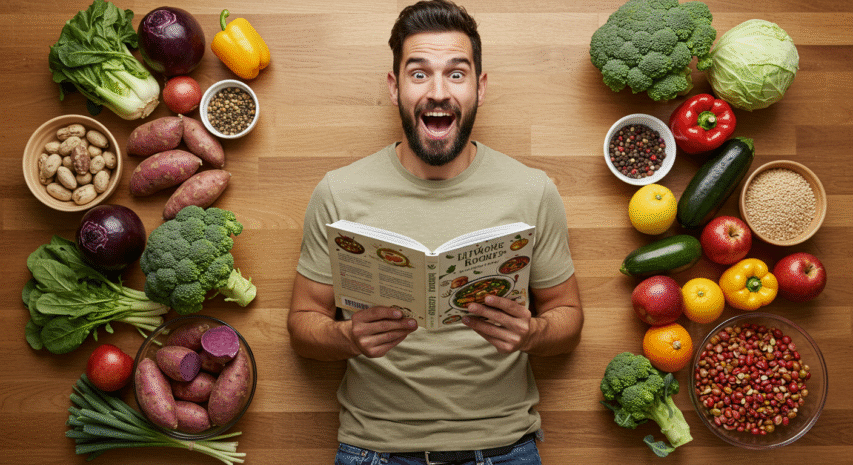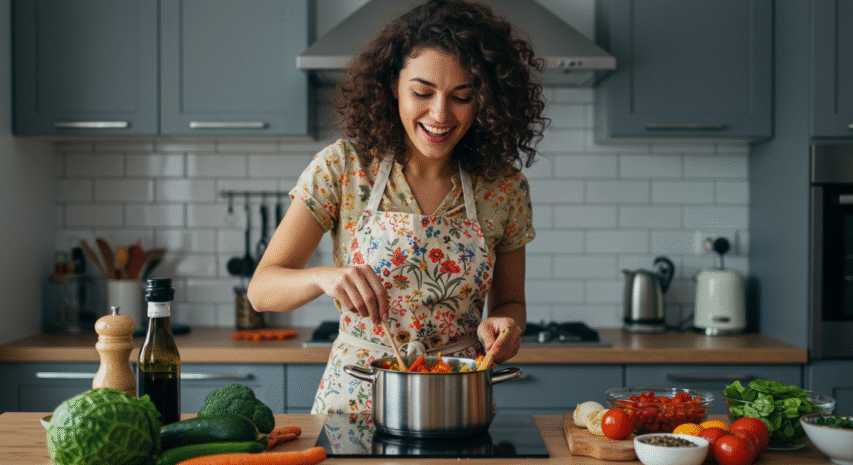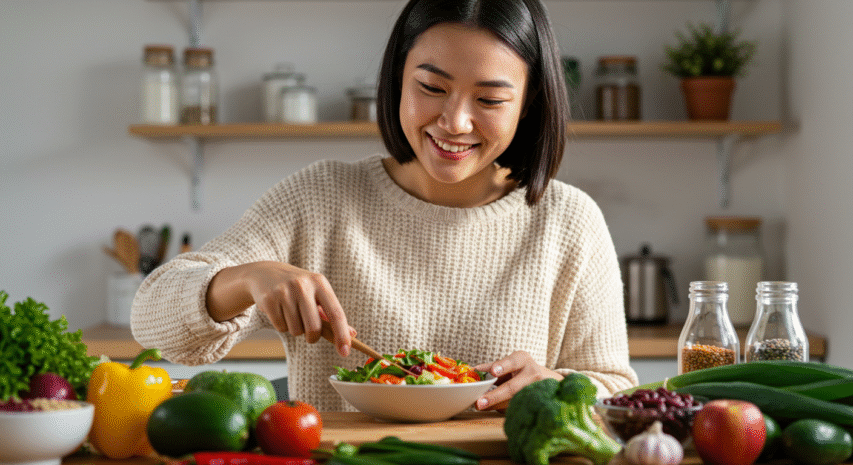Discovering the Joy of Vegan Recipes
Have you ever wondered why more people are turning to veganism every day? As someone who has embraced this lifestyle, I find the world of vegan recipes not just intriguing, but utterly delightful.
From mouthwatering desserts to hearty main dishes, the diversity and flavors are endless. The journey into veganism is not merely a dietary change but a gateway into a more conscious and exciting way of life.
As you delve into vegan cuisine, you’ll find it brimming with creativity and endless possibilities.
Over the years, I’ve experimented with countless vegan recipes, each promising a unique twist on traditional favorites.
At first glance, vegan cooking may seem daunting or limited, but once you scratch beneath the surface, it becomes apparent how inventive and satisfying it can be.
A common misconception is that vegan food lacks taste or variety, but this couldn’t be further from the truth. Let’s dive deeper into the world of plant-based culinary creation and explore what makes it so irresistible.
If you’re having trouble starting your vegan journey and sticking with it, consider joining Jeff Mitchell’s 30-Day Challenge:

The Basics of Vegan Cooking: Ingredients and Flavor
Before we dive into the heart of vegan recipes, it’s crucial to understand the foundational elements that make vegan cooking both distinctive and delightful.
When I started my vegan journey, I slowly realized the importance of selecting quality ingredients that enhance the overall flavor and texture of the dish.
| Ingredient | Function | Flavor Profile |
|---|---|---|
| Tofu | Protein source | Neutral; absorbs added flavors |
| Chickpeas | Protein and texture | Nutty |
| Coconut Milk | Creaminess | Sweet and rich |
| Agave Syrup | Sweetener | Mildly sweet |
| Nutritional Yeast | Cheese flavor | Savory and umami |
These are just a few of the ingredients you’ll often find in vegan kitchens. Each plays a specific role, be it providing a protein punch or bringing a creamy texture to dishes. Learning how to combine these ingredients effectively was a pivotal moment in my culinary exploration.
It opened up a world where I could reinvent my favorite non-vegan dishes into vegan-friendly versions without sacrificing taste or nutrition.
The beauty of vegan cooking lies in its adaptability. Ingredients can be interchanged, allowing you to reinvent recipes time and again.
Some days, the food you create may be a comforting nod to traditional meals, while other days it might be an adventurous journey into uncharted flavors.
Harnessing the Power of Spices and Herbs
Have you ever thought about how spices can transform a simple dish into an extraordinary culinary experience?
Spices and herbs are the backbone of flavor in vegan cooking, and their potential is virtually limitless. In my kitchen, they’re not just additions but essential elements that breathe life into every meal.
The moment I started experimenting with spices, my dishes evolved from bland and generic to vibrant and full of life.
Herbs like basil, cilantro, and rosemary paired with spices like turmeric, cumin, and paprika bring a multi-dimensional palette to any recipe.
Whether you’re creating a fiery curry or a soothing soup, the judicious use of spices can elevate your dish from ordinary to exceptional.

“Cooking with love provides food for the soul. Embrace the herbs and spices; they’re the language of the heart in every good vegan dish.”
Beyond taste, spices can also offer numerous health benefits. Many spices such as ginger and turmeric are renowned for their anti-inflammatory properties.
I find this aspect of spices particularly appealing as it aligns perfectly with the holistic nature of veganism, nurturing not just the body but also the soul.
Vegan Baking: Sweet Surprises
Baking without eggs, butter, or milk may seem like an impossible feat, but vegan baking has taught me otherwise.
It’s an art where creativity knows no bounds, and every bite promises a sweet surprise.
At first, I was skeptical about how vegan substitutes would fare against the dairy-rich desserts I’d grown up with, but those doubts quickly dissipated.
1- Applesauce or mashed bananas can be swapped for eggs to provide moisture and act as a binding agent.
2- Plant-based butters or coconut oil introduce the richness traditionally offered by dairy butter.
3- Almond milk or oat milk can replace regular milk, ensuring that your baked goods retain that creamy texture without animal products.
Once accustomed to these swaps, I realized that vegan baking offers endless possibilities, from fudgy brownies to airy cupcakes.
The satisfaction of crafting a delicious, plant-based dessert is unmatched and proves that compassion doesn’t come at the cost of indulgence.
The Nutritional Benefits of Vegan Dishes

The transition to a vegan diet isn’t solely about taste; it also opens the door to numerous health benefits.
Calcium, iron, and protein, usually associated with animal products, can be abundantly found in the plant-based world too.
Embracing a variety of fruits, vegetables, legumes, and grains ensures a balanced diet that meets all nutritional needs.
In my personal experience, one of the most noticeable benefits has been increased energy levels and improved digestion.
The high fiber content in vegan diets promotes gut health, while the abundant vitamins and antioxidants boost the immune system.
It’s fascinating how shifting to plant-based eating can positively influence not just physical health but also mental wellness.
Incorporating a variety of colored vegetables and fruits in meals ensures the intake of essential nutrients, providing the body with everything it needs to thrive.
Coupled with the bursts of flavor from spices and herbs, vegan dishes become not only nourishing but also incredibly satisfying.
Embracing Cultural Diversity Through Vegan Recipes
One of the joys of vegan cooking is the chance to explore culinary traditions from around the world.
As someone who loves to travel, I’ve always been fascinated by global cuisines, and adjusting these recipes to be vegan is an exciting challenge.
Whether it’s Thai curries, Italian pastas, or Mexican tacos, every culture offers a wealth of vegan-friendly dishes just waiting to be uncovered.
Cooking these global recipes allows me to connect with diverse cultures, turning my kitchen into a melting pot of flavors.
I love experimenting with unique spice blends or integrating traditional cooking techniques; every new dish is a testament to the versatility and inclusivity of veganism.
This global approach to cooking has not only expanded my culinary repertoire but has also deepened my appreciation for the rich tapestry of world cuisine.
Adopting veganism has shown me that dietary preferences needn’t be a barrier to enjoying the vast array of tastes that our world has to offer.
Overcoming Fears and Misconceptions
Venturing into veganism can seem daunting at the outset, filled with concerns about not getting enough nutrients or missing out on favorite flavors.
I faced these fears head-on, only to find them unwarranted. Veganism, in reality, offers a wholesome and fulfilling way of eating that leaves little to miss from a traditional diet.
One common myth is that a vegan diet lacks adequate protein. However, plant-based powerhouses like lentils, quinoa, and seitan prove otherwise, each presenting a robust protein profile.
It’s about rethinking our sources and recognizing the plant kingdom’s immense potential to nourish.
The key to overcoming these fears is equipping oneself with knowledge and remaining open to new experiences.
Transitioning to veganism is a journey, not a leap, and taking gradual steps helps ease the shift. Keeping an open mind and exploring new ingredients enliven the experience, turning apprehension into joy.

Building a Community Over Plant-Based Cuisine
Veganism is not only a dietary choice but a movement that fosters community and camaraderie. Connecting with others who share a passion for plant-based living creates a sense of belonging and mutual support.
Through potlucks, cooking classes, and online communities, I’ve discovered a vibrant network of individuals who inspire each other to explore veganism more deeply.
The community offers a platform to exchange recipes, share tips, and discuss the broader impact of veganism on health, the environment, and animal welfare. Experiences shared within this network have enriched my journey, showcasing the power of collective growth and understanding.
Joining such communities not only strengthens individual resolve but also amplifies the message of compassion and sustainability.
It represents a shift towards a more conscious way of living, emphasizing the significance of collective efforts in driving positive change.
The Top Five Mistakes in Vegan Cooking and How to Avoid Them
As with any culinary endeavor, there are common pitfalls one might encounter in vegan cooking.
Fortunately, these errors are easily addressed with a little foresight and knowledge. Here are the top five mistakes and strategies to avoid them:
1- Not seasoning enough. Plant-based ingredients can require more seasoning to enhance their natural flavors.
2- Overcomplicating recipes. Simplicity can often lead to the most delicious outcomes; keep recipes straightforward.
3- Ignoring nutritional balance. Ensure that meals are balanced with adequate protein, healthy fats, and fibers.
4- Not experimenting. Don’t shy away from trying new ingredients or cooking methods.
5- Forgetting texture. Combine different textures to make dishes more appealing and satisfying.
By being mindful of these common errors, you can ensure your vegan cooking journey is both rewarding and delicious, allowing every dish to reach its full potential.
Conclusion
Exploring vegan recipes is more than just a culinary adventure; it’s a transformative experience that challenges the way we perceive food and nutrition.
With creativity, community, and a touch of adventurous spirit, vegan cooking can unlock a world of flavors and benefits. It promotes not only a healthier lifestyle but also a more sustainable and compassionate approach to eating.
As I continue on this journey, the richness and diversity of vegan cooking never cease to surprise and delight me.
Whether you’re an experienced vegan or a curious newcomer, there’s a world of plant-based wonders waiting for you to discover and savor.
FAQ
Can a vegan diet provide adequate protein?
Yes, a vegan diet can provide sufficient protein through sources like beans, lentils, tofu, and quinoa, which are rich in proteins.
How can I replace eggs in baking?
Eggs can be replaced with ingredients like flaxseeds, chia seeds, bananas, or applesauce to maintain the moisture and binding qualities in baking.
Is soy the only option for plant-based protein?
No, apart from soy, there are plenty of plant-based proteins such as chickpeas, lentils, hemp seeds, and seitan available.
Will adopting a vegan lifestyle save money?
While some specialty vegan products can be costly, a plant-based diet comprising seasonal produce, grains, and legumes is generally affordable.
How do I ensure I’m getting enough vitamins on a vegan diet?
A varied diet rich in vegetables, fruits, and fortified products coupled with supplements, if needed, can cover essential vitamins.
Are vegan recipes hard to make?
They can be as simple or complex as any other recipes, with many being quick and easy to prepare with the right ingredients.

